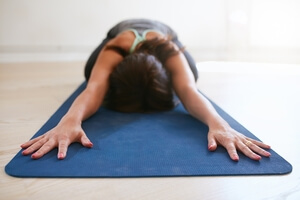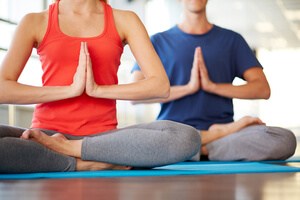
Substance addiction slowly robs you of your physical health, but treatment can help you quit abusing drugs or alcohol and begin on the road to a happier and healthier life. Exercise can supplement your recovery efforts, and for many, it is an integral part of the daily rehab routine. As it provides such a valuable range of benefits, it can be important to continue the patterns of exercise you develop while in treatment. Creating a habit of physical activity can enhance your recovery while helping to improve your overall physical and mental health.
Forming New Habits After Treatment
When someone is addicted to alcohol or drugs, they often sacrifice important occupational, interpersonal, and recreational activities in favor of substance abuse. This is because addiction involves patterns of compulsive substance use—individuals begin to use drugs or alcohol regardless of the negative consequences. People will often continue to drink and use drugs despite knowing that such activity can be injurious to their mental and physical health.1,2
The physical harm of substance abuse occurs in two ways:
1. Addiction changes priorities. It can lower the perceived importance of self-care including eating well, getting enough rest, and engaging in physical activity, leading to a poor diet, lack of sleep, and limited exercise.
2. Addiction and substance abuse can directly damage various systems throughout the body including lungs, the heart and blood vessels, brain, kidneys, and liver.
By making the decision to enter a professional addiction treatment program, you have given yourself an opportunity to break the cycle of drug and alcohol abuse and begin to repair the damage through the recovery process. Many treatment centers will address more than the impact of substances in your life as they take a holistic and comprehensive approach to improve your overall well-being.1
 Of course, rehabs will provide individual therapy, group counseling, and medication management, if applicable; they will also encourage participation in support groups, but many rehabilitation centers now focus on adding exercise and physical activity into the treatment plan. The belief is that by improving someone’s physical health, you improve their ability to establish and maintain recovery.1
Of course, rehabs will provide individual therapy, group counseling, and medication management, if applicable; they will also encourage participation in support groups, but many rehabilitation centers now focus on adding exercise and physical activity into the treatment plan. The belief is that by improving someone’s physical health, you improve their ability to establish and maintain recovery.1
Every treatment facility is different; some provide basic exercise equipment while others may offer a large health center complete with fitness professionals to guide your activity and create a personalized workout plan just for you. Combining exercise with traditional therapeutic modalities, such as cognitive behavioral therapy, can help to decrease stress and negative emotions.1 It can be easy to commit yourself to regular physical activity during rehab due to the highly structured environment, but now that rehab has ended and you want to continue exercising regularly, you will have to make a plan to help stay on track and meet your goals.
When you leave rehab, the return of old habits can present challenges to your recovery and to your overall wellbeing. To stay on track, it can help to impose some amount of self-discipline in the form of regular meeting attendance or participation with other forms of aftercare, relapse prevention, and general recovery support. A structured exercise routine can be a part of this. Maintaining the healthy practices you began in rehab is essential to your ability to lead a life based on fulfillment and happiness, and one of the best habits to maintain is regular exercise.
How to Create a Workout Routine
Creating a workout routine seems like it should be simple. Just figure out what you want to do, and go for it.
Unfortunately, the process can become overwhelming quickly as you are flooded with countless exercise options and opinions from friends and experts. You may find yourself asking questions like:
- What kind of exercise plan should I use?
- How long should I exercise?
- How often should I exercise?
- How intensely should I exercise?
- Should I give up if I don’t get the desired results?
 The pressure of making the “right” choices can make you give up on your exercise plan before it even starts. Keep in mind that no one expects you to have all the answers when it comes to your new exercise regimen, so it’s vital to keep your expectations of yourself fair.
The pressure of making the “right” choices can make you give up on your exercise plan before it even starts. Keep in mind that no one expects you to have all the answers when it comes to your new exercise regimen, so it’s vital to keep your expectations of yourself fair.
A great starting point in your exercise plan is consulting with a professional to devise your workout. Consider meeting with your medical doctor to see if they have any concerns regarding your physical health and ability to exercise. From there, if you have the means and the green light from your doctor, schedule an appointment with a personal trainer to go over workouts appropriate for you.
When starting or restarting an exercise program, consider these helpful tips:3
- Set a reasonable goal. What do you want to accomplish through exercise? As long as your mission is specific, attainable, and measurable, you’ll be headed in the right direction.
- Start slowly. Unlike substance use, exercise might make you feel worse when you start. Begin at a very light level and gradually build up over time to increase motivation and confidence. If you jump in too intensely, you risk injury, discomfort, and frustration.
- Practice kindness. Exercise sometimes leads to people being too hard and demanding of themselves. If you have to miss a day or you aren’t meeting your goals quickly enough, be understanding rather than judgmental.
- Add variety. Performing the same set of exercises every day is going to become monotonous very quickly. Mix up and vary your routines to keep exercise fresh, exciting, and interesting.
- Stay confident. The way you talk to yourself influences your mood and motivation. Stay upbeat while you focus on the positives that come from exercise.
Exercise does not have to be a solitary activity. By forming or joining a group of people dedicated to physical health, you can find new ways to stay accountable as you provide motivation for others.
Remember, you may not find the perfect exercise plan immediately. Continue to experiment with different options at different intensities at different times of the day until you find a fit that works for you.
Available Exercise Options
Just because one exercise plan works for someone you know doesn’t mean it will necessarily work for you, and that’s okay. You are an individual with unique needs, demands, and preferences.
Fortunately for you, there are numerous exercise options like:4
- Endurance exercise. Perhaps the most well-known form of physical activity, endurance or aerobic exercise refers to any workout that increases your breathing and heart rate. Aerobic workouts are great because they keep your heart and lungs healthy and strong. Types of endurance exercise include:
- Walking.
- Jogging.
- Swimming.
- Biking.
- Hiking.
- Dancing.
- Many team sports – basketball, soccer, football.
- Strength training. These exercises focus on increasing muscle strength through the use of weights, kettlebells, and resistance bands. Strength training is more than just repetitively bench pressing a barbell; it includes great options for people from any background.
- Balance exercise. Balance exercises are effective exercises that can improve your daily movements and help avoid falls. Activities like yoga or tai chi can boost your stability and safety.
- Flexibility exercise. Rather than being aimed only on building muscle, flexibility exercises help to stretch your muscles. Flexibility exercises make you more limber, which prevents injuries. Yoga is a great example of this exercise style.
Keep experimenting with activities and types of activities until you find something that you truly enjoy. The good news is you don’t have to settle on only one type of exercise. Some of the best workouts will include aspects of all exercise types to form a well-rounded program.
Various Benefits of Being Active
The benefits of exercise for improving someone’s physical and mental health are so well-researched that there is little doubt regarding the pros. But can exercise actually help people with addiction get clean and stay clean for longer periods of time?
It turns out the answer is yes! According to a meta-analysis study, exercise can:5
- Ease withdrawal symptoms.
- Increase abstinence rate.
- Reduce depressive symptoms.
- Decrease feelings of anxiety and worry.
The good news is that these benefits were not limited to only one type of exercise. The study confirmed that aerobic exercises, such as running and brisk walking, and mind-body exercises, such as yoga and tai chi, both elicited significant improvements. Additionally, the benefits were not impacted by the intensity of exercise.5
 Exercise’s power to battle drug and alcohol abuse is life-changing, but what creates these accomplishments? It may have to do with exercise’s effects on the brain.
Exercise’s power to battle drug and alcohol abuse is life-changing, but what creates these accomplishments? It may have to do with exercise’s effects on the brain.
Although every substance affects the brain differently, generally speaking, substance abuse causes reinforcing changes in the brain due to the effects on neurotransmitters. Over time, chronic drug or alcohol abuse can cause lasting changes in brain function and structure. Studies now demonstrate that exercise can target these same reinforcing pathways in the brain.6
For example, using certain drugs, such as stimulants, alcohol, and opioids, is associated with increased activity of dopamine, a neurotransmitter system involved with pleasurable feelings and a sense of reward. It turns out that dopamine activity also increases following a period of acute exercise, so the physical activity replicates–on a smaller scale–the immediate effects of substance use.6 Moreover, long-term physical activity can actually create positive lasting changes in the dopaminergic system.6
Other chemical messages, like norepinephrine, glutamate, and opioids made in the body, are influenced by exercise as well:6
- Norepinephrine. Exercise will reduce the release of norepinephrine in the system, resulting in a decrease in stress.
- Glutamate. Chronic drug use may ultimately lead to glutamate overstimulation. Exercise can help restore glutamate signaling to a healthier baseline. By normalizing the excessive glutamate signaling that develops after prolonged drug use and blunting the glutamatergic response to drug cue exposure, exercise may help reduce the risk of relapse.
- Opioids. Drugs like heroin and morphine are opioid drugs of abuse, but the body produces its own natural version, called endogenous opioids (e.g., endorphin, enkephalin, etc.). Exercise sparks the release of these chemicals into the body to create a positive feeling.
In short, there is no down side to supplementing your recovery with an exercise routine. Physical activity can serve as a non-substance reinforcer that not only heals your body, but also improves mood and reduces stress.6
Fostering a Balance to Enhance Recovery
 If you are learning this information for the first time, you might have the inclination to give up all treatment to focus on exercise. Be careful, though. Exercise has many advantages, but you must practice moderation as you bring physical activity into your life. Too much of a positive can quickly become a negative.
If you are learning this information for the first time, you might have the inclination to give up all treatment to focus on exercise. Be careful, though. Exercise has many advantages, but you must practice moderation as you bring physical activity into your life. Too much of a positive can quickly become a negative.
Addictions are marked by losing balance in life, and some people trade an addiction to drugs for an addiction to exercise. Any addiction can be damaging and distressing.
Addiction to exercise won’t happen immediately. Instead, there is a four-step process:7
- Recreational exercise. This first phase involves exercise based on health and fitness. Here, the person is under control, maintains their goals, and rarely encounters unwanted outcomes.
- At-risk exercise. In this phase, people are more interested in the mood-altering effects of exercise. They are highly involved in exercise and:
- Frequently think about exercise.
- Experience mood changes related to exercise.
- Feel compelled to exercise more to feel better.
- Problematic exercise. People in this stage begin to reorganize and restructure their lives around exercise. The level of intensity and duration of exercise increases, even after the person accomplishes the goal they set out to achieve.
- Exercise addiction. At this point, exercise consumes the person’s life, resulting in negative outcomes like:
- Physical injuries and poor health due to limited self-care.
- Damaged relationships.
- Financial problems stemming from missing work to exercise or paying for several expensive memberships or programs.
Exercise addictions may also trigger other addictions or unhealthy behaviors, like eating disorders.7
Exercise is important but so is rest, which is why moderation is key. Without taking time to heal and recover between periods of exercise, the benefits of physical activity dwindle, and you are more likely to become burned out and frustrated with exercise.
Life in recovery will be more enjoyable and rewarding with balance. Exercise cannot be your entire treatment program, but it can be a critical component of lifelong recovery.
The best recovery plans cover every part of your life including your physical, mental, social, and spiritual health. If you find too much of your energy being committed to one aspect of your health, take a moment to reflect on your treatment and adjust your direction as needed.
Sources
-
1. National Institute on Drug Abuse. (2018). Principles of Drug Addiction Treatment: A Research-Based Guide.
2. American Psychiatric Association. (2013). Diagnostic and statistical manual of mental disorders (5th ed.). Arlington, VA: American Psychiatric Publishing.
3. National Institute on Aging. (n.d.). Starting to Exercise Again After a Break.
4. U.S. National Library of Medicine: MedlinePlus. (2017). Exercise and Physical Fitness.
5. Wang, D., Wang, Y., Wang, Y., Li, R., & Zhou, C. (2014). Impact of Physical Exercise on Substance Use Disorders: A Meta-Analysis.
6. Smith, M. A., & Lynch, W. J. (2011). Exercise as a Potential Treatment for Drug Abuse: Evidence from Preclinical Studies. Frontiers in Psychiatry, 2, 82.
7. Freimuth, M., Moniz, S., Kim, S. (2011). Clarifying Exercise Addiction: Differential Diagnosis, Co-occurring Disorders, and Phases of Addiction. Int. J. Environ. Res. Public Health 2011, 8(10), 4069-4081.
